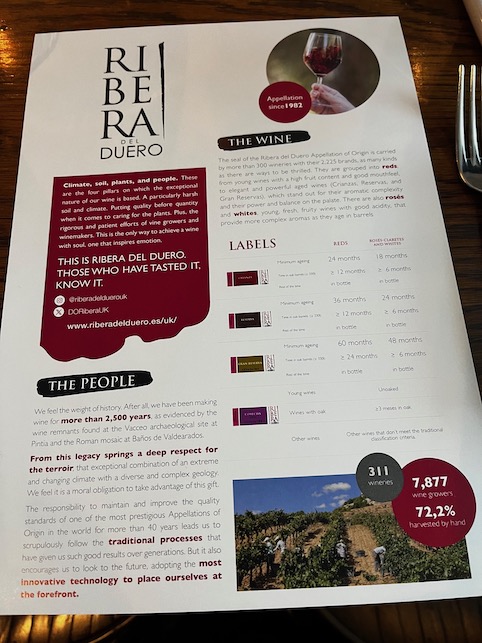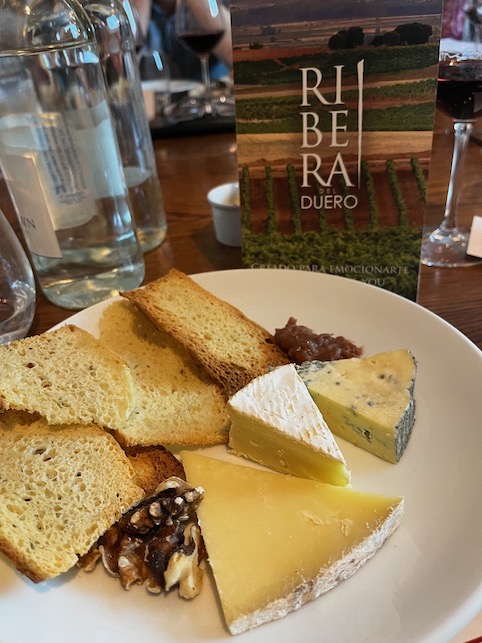Luisa finds out why altitude matters when making Ribera del Duero DO wines.
One of Spain’s top red wine producing regions, you will find Ribera del Duero in the northwest of the country, about two hours north of Madrid, in the district of Castilla y Léon, the largest region.
As well as being one of the most high-quality wine appellations, it is also one of the most elevated for growing vines. The region’s vineyards flank the Duero River to the north and south, stretching up to the limestone cliffs where the valley meets the Meseta Central, a plateau which rises between 700 and 1,000 metres above sea level.

The area’s fascinating wine history points to a Roman influence in the 4th and 5th centuries with recently discovered mosaics depicting scenes of happy imbibing with Bacchus, the god of wine.
In the 12th century wine making was refined by Benedictine monks, who brought their practices from Burgundy. In the mid 1800’s, Eloy Lecanda y Chaves gained his place in the area’s wine history: a Bordeaux trained Spanish winemaker, he established the world-famous Vega Sicilia, and went on to create artful wine blends with significant success.
Today, with its 26,000 hectares of vineyards throughout the region, around 8,000 wine growers, and an Appellation of Origin (DO) carried by more than 300 wineries with their 2,225 brands, it is no surprise that the Ribera del Duero DO wines are making waves, and are much loved in the UK.
Key to the quality of these wines is the altitude at which the vines are grown. Top of the range Pago De Los Capellanes, Un Seuño En Las Alturas 2020 (available from vinissimus.co.uk) comes from Tempranillo vines grown at 1,000 metres, where the hot days are balanced by the cool nights, to slow the grapes from reaching ripeness too quickly, thus increasing quality.
Expect to pay around £60 for this wine, but it’s worth every sip. Delight in the forest fruits with distinct notes of cassis, raspberry and blueberry, and a fresh minty note. Concentrated and lingering finish, but an exceptional balance of fruit and herbal notes.
The extreme climate is another influencing factor: dry summers and long harsh winters with low rainfall and a wide range of temperatures. It’s often described as ‘nine months of winter and three months of hell’, when the summers are hot but very dry, hence altitude is paramount in cooling the vines at night.
Another reason to celebrate Ribera del Duero’s uniqueness is its soil – or rather, 33 types of soil. At an altitude of between 700 – 1,000 metres, nature and the passage of time have generated a soil with exceptional characteristics with layers of clayey sand alternated to limestone. The vines that take root here, produce the best fruit and, as a result of climate and soil, extraordinary quality grapes are produced, with thick skins and perfect, slow and late ripening.
Bodega Felix Callejo, El Lebrero de Callejo 2021 is another great example of what Ribera del Duero DO can produce. This family owned and operated winery from the village of Sotillo de la Ribera, which features on the label, makes organic wines from grapes grown at an altitude of 930 metres with a range of suitable arid soils. Here the vines thrive, with Tinto Fino (more commonly known as Tempranillo), Garnacha, Merlot and Albillo Mayor.

Bursting with ripe red fruit scents, along with toasted oak and cocoa, spice and fresh mint. It is an excellent partner for a charcuterie board, pork and grilled chorizo. This wine encapsulates freshness, acidity, depth of colour and ageability. Excellent now, it will be even better in 10 years’ time. Find it at 8wines.com for around £23.
Whilst Ribera del Duero mainly produces red wines, there are whites and rosés made as well. Here, grapes are rather special too, including Albillo Mayor, a unique white grape. Indigenous to the area, in 2010 it was discovered that it is a parent of Tempranillo.
This grape buds and ripens early and produces low yields. Albillo wines are full-bodied with low to medium acidity and flavours of pineapple, apple and pear with hints of fennel. Historically, the variety has been blended with Tempranillo to add brightness, but new DO regulations now permit wins produced with at least 75 percent of the grape.
Nabal Rosé Rosado de Lacrima 2023, a blend of Tempranillo, Albillo Mayor and Garnacha, is a fine and elegant expression with intense and fresh varietal aromas, reminiscent of red fruits and strawberries and a subtle suggestion of rose petals. Not widely available yet, but worth mentioning.
What’s happening in Ribera del Duero today?
The wines are attracting increasing international attention. The region is second only to Rioja for total DO wine production in Spain. Whilst there are some large producers, Ribera del Duero is made up for the most part of small, family-owned wineries.
It’s the climate, soils and growing conditions that give these wines their distinctive character which truly express the regional terroir. Riberadelduero.es/uk
